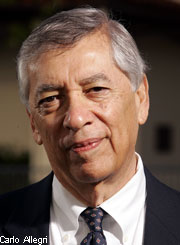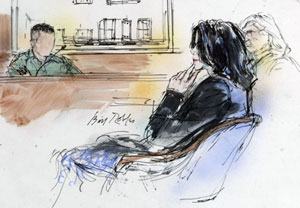 |
 | ||||||||||
Michael Jackson
|
 |
|||||||||
|
I'm up at 5:30AM, ready to leave the hotel at 7. I arrive at Camp Jackson to drop off my case-- a legal case on wheels, with a handle-- at the media tent. After breakfast, I go to the courtroom and sit in the front row seat designated by the Superior Court of Santa Maria, California, right by the jurors. Jackson pops in at 8:20 to 8:28AM and the judge begins at 8:30, to the minute. I look at the defendant, his accusers, and their attorneys. I check out what the accused is wearing, to get the colors right, and note any crest or medallion and the buttons on his vest. I'm Bill Robles, one of three courtroom sketch artists at the Michael Jackson trial.
Judge Rodney Melville runs a tight court, with three 10-minute breaks, but no lunch. Itís called ďthe Melville diet.Ē I make one or two drawings with marker and color wash during the first session from 8:30- 9:45AM, add final touches at the break and run it outside, the vellum flapping in the wind until I tack it to a piece of foam core.
We have an easel set up, with a 23Ē x 23Ē piece of white masonite, where TV crews and still photographers line up to shoot my work for television and print. At the arraignment and on the first day of jury selection, twenty-eight TV stations and news outlets queued up. In this day of digital this and digital that, they still depend on me, my $20 drawing pad, pen and markers in my hand, to come up with the images sent on the satellite around the world to millions.
By the time court adjourns at 2:30PM, as promptly as it began, Iíve drawn 6-8 sketches. One of each witness who takes the stand, a ďJackson,Ē the judge and the attorneys. Lawyers tend to have certain positions. Defense attorney Tom Mesereau leans on one elbow; prosecutor Thomas Sneddon puts both hands on the podium or stands with his arms crossed. You wait for certain gestures to make the drawing interesting; action makes it more dramatic.
The worst part of my job is the piracy of my art, when it gets broadcast without my knowledge or permission.
The best part of my job is the excitement of working on deadline in the center of this exciting trial. You can execute your art in any way you want, and if the results are there, you are respected by your colleagues in the media. You know the requirements, to fit the format of the tv screen, and youíve got to keep it simple and clear. I try to keep it as it looks, within a vignette format, where the drawing kind of floats, losing the edges. I use brighter colors around the face to add a little more kick. Michael Jackson is so tall and thin. He was looking green last week, so I used a little extra blue and green. With his gaunt cheekbones, from my side view, his hair covers most of his face, unless he turns his head. Sometimes Iíve only put a nose, and chin and a little jaw showing.
Michael Jackson, a worldwide figure, seems very gentle and humble. At one point he approached me in court during jury selection to ask for one of my business cards, which has his image on it, by the way. It was incredible; when I showed him a drawing of himself with his attorneys, he lit up like a Christmas tree; usually itís the lawyers who ask.
While court is in session, I listen to the evidence, I look at the fascinating faces. Iím not allowed to draw the jurors, who glance at me a bit, but usually everyone is transfixed by what is going on in court.
Everybodyís exhausted at the end of the day. By the time you completely wrap up, itís 3:30 or 4PM.
When I look back at all the time I've spent in court, I know Iíve had a role in something big; I think about the circumstances that brought me together with the person that I read about. History put me into the hub of things.
© Bill Robles
Dispatches are brought to you by Canon. Send Canon a message of thanks. |
||||||||||
Back to April 2005 Contents
|
|



